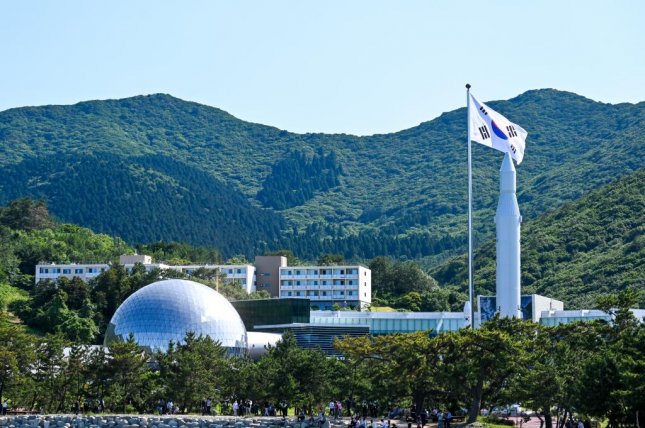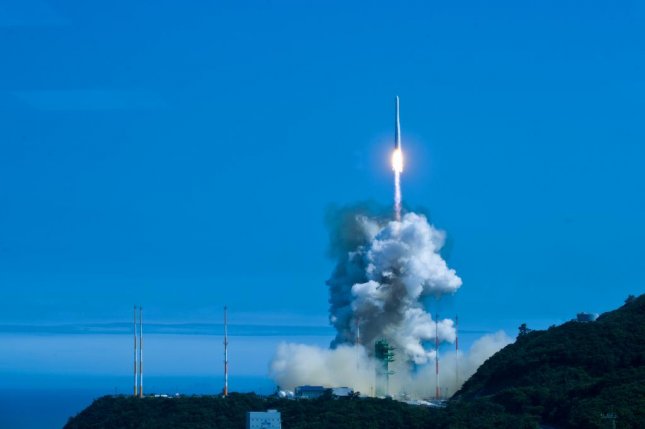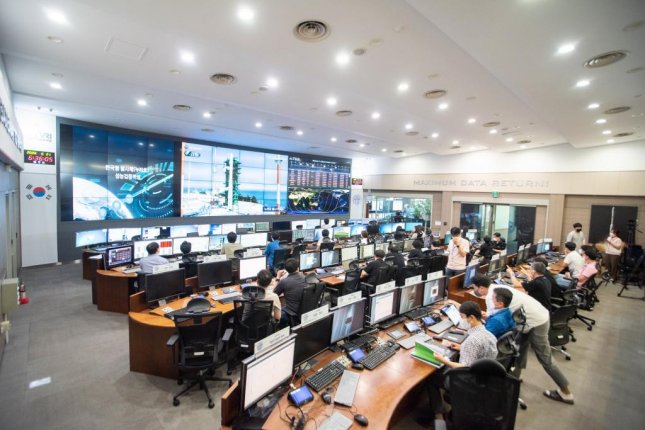
 With the launch, South Korea became the tenth country to send a satellite into space with its own technology and the seventh to develop a space launch vehicle that can carry a satellite of more than 1 ton. Photo courtesy South Korean Ministry of Science and ICT
With the launch, South Korea became the tenth country to send a satellite into space with its own technology and the seventh to develop a space launch vehicle that can carry a satellite of more than 1 ton. Photo courtesy South Korean Ministry of Science and ICT
Goheung, SOUTH KOREA, June 21 (UPI) — South Korea successfully launched its first homegrown rocket on Tuesday, deploying a satellite into low-Earth orbit in a major milestone as the country jumps into the space race with both commercial and military implications.
The three-stage Nuri rocket blasted off from the Naro Space Center in the southern coastal town of Goheung on Tuesday afternoon. It reached its target altitude of 435 miles and released a 360-pound performance verification satellite as well as a 1.3-ton dummy satellite, South Korea’s Ministry of Science and ICT said.
“Today is a very monumental day in South Korean history,” science minister Lee Jong-ho said at a press briefing after the launch. “The sky has opened up for us and we made a great step forward in space exploration.”
With the launch, South Korea became the tenth country to send a satellite into space with its own technology. It is the seventh country to develop a space launch vehicle that can carry a satellite of more than 1 ton, following the United States, China, Japan, France, Russia and India.

“It is meaningful that we don’t have to borrow other nation’s rockets anymore,” Lee added. “We can do it on our own. [Today’s launch] will become a stepping stone to the next space era.”
Directly outside of the space center, dozens of spectators found spots among the rocky coastline to take in the spectacle, cheering loudly as the rocket rumbled and then appeared from behind a low mountain before climbing into a bright blue sky.
The launch was the second liftoff for the 2-ton Nuri rocket, also known as the Korean Space Launch Vehicle II, after a mission in October failed to successfully deliver a dummy satellite. South Korea has spent more than $1.5 billion developing Nuri since 2010 and has four more launches scheduled through 2027.
Lee Sang-ryool, head of the Korea Aerospace Research Institute, said after the launch that all phases proceeded normally and that satellites were deployed at “exactly the intended altitude and speed.”

KARI confirmed that the satellite successfully communicated with a South Korean research station in Antarctica roughly 40 minutes after launch.
Tuesday’s accomplishment was not just a technical exercise. Seoul has prioritized space technology as a growth industry and the government has laid out a roadmap to deploy next-generation communications and navigation satellites. The science ministry has said it will transfer launch vehicle technologies to the private sector to help spur development.
South Korean President Yoon Suk-yeol praised Tuesday’s successful launch and said “the dreams and hopes of the Korean people now extend into space.” In a video call with researchers, Yoon vowed to create an aerospace agency to further develop the industry.
The country is also looking to space to bolster its defense capabilities amid a growing arms race on the Korean Peninsula.
South Korea has previously relied on the U.S. military to monitor the North, but Seoul has signed a contract with Elon Musk’s SpaceX to launch five spy satellites by 2025, with the first launch on a Falcon 9 rocket in 2023. Much of the activity in South Korea’s space sector comes on the heels of an agreement with the United States last year to end decades-long restrictions on Seoul’s missile development.
The restrictions, which were first introduced in 1979, originally limited South Korea-developed rockets to a flight range of around 110 miles and a payload of 1100 pounds. The guidelines were revised multiple times over the years until they were finally lifted in May 2021 during a summit between U.S. President Joe Biden and then-South Korean President Moon Jae-in.

While North Korea has stayed in the spotlight with a flurry of weapons tests since the beginning of 2022, South Korea has shown off military hardware of its own, including a submarine-launched ballistic missile and a supersonic cruise missile.
In March, the military successfully tested its first home-produced solid fuel rocket, a boost to its space-based defense capabilities.
South Korea’s space ambitions also extend to the moon. The country is scheduled to launch its first lunar orbiter in August aboard a SpaceX rocket, and is aiming to send a landing module to the moon using South Korean rockets by 2031.
Español:
Corea del Sur lanza cohete Nuri de cosecha propia en un importante hito espacial
 Con el lanzamiento, Corea del Sur se convirtió en el décimo país en enviar un satélite al espacio con tecnología propia y el séptimo en desarrollar un vehículo de lanzamiento espacial que puede transportar un satélite de más de 1 tonelada. Foto cortesía del Ministerio de Ciencia y TIC de Corea del Sur
Con el lanzamiento, Corea del Sur se convirtió en el décimo país en enviar un satélite al espacio con tecnología propia y el séptimo en desarrollar un vehículo de lanzamiento espacial que puede transportar un satélite de más de 1 tonelada. Foto cortesía del Ministerio de Ciencia y TIC de Corea del Sur
Goheung, COREA DEL SUR, 21 jun (UPI) – Corea del Sur lanzó con éxito su primer cohete de cosecha propia el martes, desplegando un satélite en órbita terrestre baja en un hito importante a medida que el país se lanza a la carrera espacial con implicaciones comerciales y militares.
El cohete Nuri de tres etapas despegó del Centro Espacial Naro en la ciudad costera sureña de Goheung el martes por la tarde. Alcanzó su altitud objetivo de 435 millas y lanzó un satélite de verificación de rendimiento de 360 libras, así como un satélite ficticio de 1.3 toneladas, dijo el Ministerio de Ciencia y TIC de Corea del Sur.
“Hoy es un día muy monumental en la historia de Corea del Sur”, dijo el ministro de Ciencia, Lee Jong-ho, en una conferencia de prensa después del lanzamiento. “El cielo se ha abierto para nosotros y hemos dado un gran paso adelante en la exploración espacial”.
Con el lanzamiento, Corea del Sur se convirtió en el décimo país en enviar un satélite al espacio con su propia tecnología. Es el séptimo país en desarrollar un vehículo de lanzamiento espacial que puede transportar un satélite de más de 1 tonelada, después de Estados Unidos, China, Japón, Francia, Rusia e India.

“Es significativo que ya no tengamos que pedir prestados los cohetes de otras naciones”, agregó Lee. “Podemos hacerlo por nuestra cuenta. [El lanzamiento de hoy] se convertirá en un trampolín hacia la próxima era espacial”.
Directamente fuera del centro espacial, docenas de espectadores encontraron lugares entre la costa rocosa para disfrutar del espectáculo, vitoreando en voz alta mientras el cohete retumbaba y luego apareció desde detrás de una montaña baja antes de subir a un cielo azul brillante.
El lanzamiento fue el segundo despegue para el cohete Nuri de 2 toneladas, también conocido como el Vehículo de Lanzamiento Espacial COREANO II, después de que una misión en octubre no pudo entregar con éxito un satélite ficticio. Corea del Sur ha gastado más de $ 1.5 mil millones en el desarrollo de Nuri desde 2010 y tiene cuatro lanzamientos más programados hasta 2027.
Lee Sang-ryool, director del Instituto de Investigación Aeroespacial de Corea, dijo después del lanzamiento que todas las fases se desarrollaron normalmente y que los satélites se desplegaron a “exactamente la altitud y velocidad previstas”.

KARI confirmed that the satellite successfully communicated with a South Korean research station in Antarctica roughly 40 minutes after launch.
Tuesday’s accomplishment was not just a technical exercise. Seoul has prioritized space technology as a growth industry and the government has laid out a roadmap to deploy next-generation communications and navigation satellites. The science ministry has said it will transfer launch vehicle technologies to the private sector to help spur development.
South Korean President Yoon Suk-yeol praised Tuesday’s successful launch and said “the dreams and hopes of the Korean people now extend into space.” In a video call with researchers, Yoon vowed to create an aerospace agency to further develop the industry.
The country is also looking to space to bolster its defense capabilities amid a growing arms race on the Korean Peninsula.
South Korea has previously relied on the U.S. military to monitor the North, but Seoul has signed a contract with Elon Musk’s SpaceX to launch five spy satellites by 2025, with the first launch on a Falcon 9 rocket in 2023. Much of the activity in South Korea’s space sector comes on the heels of an agreement with the United States last year to end decades-long restrictions on Seoul’s missile development.
The restrictions, which were first introduced in 1979, originally limited South Korea-developed rockets to a flight range of around 110 miles and a payload of 1100 pounds. The guidelines were revised multiple times over the years until they were finally lifted in May 2021 during a summit between U.S. President Joe Biden and then-South Korean President Moon Jae-in.

While North Korea has stayed in the spotlight with a flurry of weapons tests since the beginning of 2022, South Korea has shown off military hardware of its own, including a submarine-launched ballistic missile and a supersonic cruise missile.
En marzo, el ejército probó con éxito su primer cohete de combustible sólido producido en casa, un impulso a sus capacidades de defensa basadas en el espacio.
Las ambiciones espaciales de Corea del Sur también se extienden a la Luna. El país está programado para lanzar su primer orbitador lunar en agosto a bordo de un cohete SpaceX, y tiene como objetivo enviar un módulo de aterrizaje a la Luna utilizando cohetes surcoreanos para 2031.











